Oh, this is a difficult one because quite honestly, there are so many pools, spas and springs to bathe in that the only true itinerary I could give you is to take a month and just drive all the way around Iceland, stopping everywhere. Every settlement with more than about ten people living there has a geothermal pool, the vast majority of them outdoors and virtually all of them with hotpots. What’s more, once you’re out of Reykjavik you have a good chance of having those pools all to yourself.
But that’s not what I’m here for. I’m here to show you the best way to see whatever it is you want to see. So here’s my five-day Iceland itinerary for waterbabies. It’s a summer one – the pools and spas are open year-round but a couple of things on this list are closed or inaccessible in winter. Bring your swimming stuff, and bring spares unless you’re happy to put on a suit that’s still wet from earlier in the day.
Day one
Iceland’s capital is named Reykjavik, which means Smoky Bay. It wasn’t actually smoky; it takes its name from the steam that drifted up from its beaches and fields back in the 700s when Ingolfur Arnarson arrived and it still has plenty of places to enjoy that geothermal heat. As usual, I’ve created a map and anything that isn’t on a specific day I’ll leave in its own category at the bottom so you can extend this day or pick something other than what I’ve recommended. There are three pools within Reykjavik itself, plenty more within a short drive out of the city and there’s the new Sky Lagoon spa on the headland opposite at Kópavogur.
But I’d suggest starting with Nauthólsvík Geothermal Beach. Yes, a geothermal beach, the only one of its kind that I know of, certainly in Iceland. Take bus 5 or 8 from the BSI terminal towards Nauthóll every ten minutes or walk towards the Natura Hotel and keep going. It’s not a huge beach and it advertises cold water swimming but it’s not freezing like it should be because of the geothermal heat keeping it lukewarm and it has a big hot water trough on the beach and a hot tub in the water. I’ve not been myself because I tend to use summer, which is the only time it’s open, to go out and about around the island. But it’s something I keep meaning to do and I think if you’re here for geothermal hot water, this is a really interesting and unique place to encounter it.
Go back into Reykjavik afterwards, find a cafe and warm up maybe. Do some shopping. Enjoy your day exploring Reykjavik. Then, later on, head out to one of the pools. Icelanders treat the local pool like the British treat the local pub. It’s where they go after work to chill out and meet friends. The most convenient is Sundhöllin, the oldest public pool in Iceland. It’s on Snorrabraut, so if you’re heading up there anyway, it’s nice and easy. If not, it’s kind of just behind Hallgrímskirkja, which is that huge concrete space shuttle/basalt-shaped church you can see from everywhere. Worth adding to your afternoon in Reykjavik, by the way. Sundhöllin is nice – the original indoor pool is a bit chilly but the outdoor one in the new extension is toasty, as are the rooftop hotpots. Too toasty – I tend to perch on the edge with my feet in the water so as to not actually get boiled.

However, I personally would go to Laugardalslaug, which is something of a flagship. It’s just a local pool but it’s good. It has a 50-metre geothermal heated outdoor pool and an indoor pool which I think is also 50m. It has four hotpots of varying temperatures down the side and a saltwater spa, which is just a hotpot that tastes funny. There’s a bulge off the side of the lane pool for games, with basketball hoops and slides. There’s a warm social pool where you sit on rocks and steps and that’s where I spend most of my time. Finally, I believe there’s a collection of saunas and steam rooms inside. All for the price of a visit to your own local dingy underheated council pool. Take bus 14 towards Verzlo; it’s a bit of a walk. You can’t come to Iceland as a swimming fan and miss Laugardalslaug.
Day two
This is a bit of a long day but I think this is another one you can’t miss. It’s the hot spring at Landmannalaugar. You’ll need a group tour for this because it involves a long ride out into the Highlands and it’s not recommended you drive yourself. First and foremost because there’s a river crossing and it’s not as easy as you might think it is. Second, very few rental cars are legally allowed to be driven onto the F-roads. Third, the road is little more than two lines of dust in the middle of a gravelly nothing. I’ve watched satnavs lead us across this plain and I have no idea how you navigate when the screen shows you a line across nothing and there’s nothing in front. You’ll find plenty of tour companies in the summer for this – you can go for the cheapest option which is a 60-something seater coach or you can do a private 4×4/superjeep tour depending on your budget. It’s also not completely impossible to do this trip in winter but it all looks very different.

Landmannalaugar is a little oasis in the middle of the Highlands, comprising a campsite, a few huts, a lot of hiking trails – and a warm bathing pool on the edge of a lava field. The lava field was laid down 500 years ago by the mountain peeking over the top of it and it’s still hot enough to boil the water that bubbles through it. That boiling water runs into a freezing stream and the two come together in a pool of perfect bathing temperature. Changing facilities are somewhat basic: a kind of wooden gallows-thing next to the pool, unless you prefer to change in the shower block and run the couple of hundred metres across to the water in your swimsuit. It gets pretty busy in the middle of the day, when all those tour groups arrive pretty much at the same time so to really appreciate it, you should stay overnight or come on a specialist expensive trip in the winter but for the purposes of this itinerary, we’re doing a day trip. Most of the tourists won’t go in the water. No one ever reads the blurb properly and more than half of them remain cheerfully oblivious to this wonderful pool.

There are showers and toilets up at the purpose-built barn – I don’t know how much showers cost at the moment but you’ll need to pay the facility fee for use of the toilets and the lunch shelter. There’s a good chance this is included in your tour but if not, you can either pay 400kr online for the wristband or 500kr to the warden on the day. I do recommend a shower. Trying to keep this bit short and quick – the water contains a parasite that has caused paralysis in ducks. I’ve never heard of it harming humans but I’d have a thorough wash afterwards just in case. Icelandic showers are universally permanently warm because they’re powered by the Earth.

You won’t get much else done today. You’ll leave by about 8am and I’d be astonished if you get back by 6pm – 8-8 is more likely. However, you’ll have a good look at the countryside in the south west and do take the time while you’re at Landmannalaugar to enjoy the stripy rhyolite mountains as well as indulging in the pool.
Day three
Today you’re going to get up nice and early for a flight up to Akureyri. You can drive but it takes about five hours whereas the flight is only 45m. They go about four times a day but if you get one of the earlier flights – today there’s one at 07:10 for £65 which will give you plenty of time up north. This is a good day for hiring a car – you can take the long-distance bus from Akureyri to Myvatn and hop off outside the little supermarket in Reykjahlid but even if you’ve got the early plane, you’ll still have missed most of the day tours around the area.

Drive across to Reykjahlid, stopping off at Goðafoss – it’s a detour of less than half a mile off the main road and it’s where Þorgeirr Ljósvetningagoði Þorkelsson allegedly threw his chief poles into the waterfall to signify the throwing aside of the old pagan religions and the taking-up of Christianity. More definitely, it’s a pretty waterfall and worth stopping for.

There’s so much to do in the Myvatn area. You could drive up the long rickety road to Dettifoss, continue to Ásbyrgi canyon and return via the other road, or you could drive up past the village and out to the Krafla geothermal area, where you can visit the still-steaming Leirhnjúkur lava field, the Hverir geothermal area and the Eternal Shower – it’s a hot shower running perpetually on the side of the road. However, it’s surrounded by a huge puddle which the warm water has turned into a positive bog of thick green stuff so I wouldn’t shower under it unless you’re wearing wellies. Or waders.

Two interesting spots nearer the village are Grjótagjá and Stóragjá, both rifts in the vicinity of Reykjahlid. Grjótagjá – and it burns me to say is – is a filming location for Game of Thrones but as far as I’m concerned, it’s a little cave caused by the lifting of the ground during some tectonic event and flooded with hot blue water. You’re not supposed to bathe in it and I strongly discourage it because the cave roof is unstable and the water is too hot and it’s a bit of a pain to get in and out of. Stóragjá is another rift, a taller but tighter one, which you descend with ladders and ropes. Again, don’t swim here – this one’s teeming with bacteria and in particular e-coli, which you do not want to pick up when you’ve got so many other swimming options.

When you’ve spent most of the day exploring the region, it’s time to go to Jarðböðin, the Myvatn Nature Baths, which are perched on the slopes of the active volcano. It’s a lagoon, a small, quieter, wilder cousin of the Blue Lagoon where you’ll see sulphur-streaked orange mountainside behind you and a sweeping vista across to Myvatn in front of you. It’s had some updates since I was last there: I believe you can now get a wristband with which you can purchase in-water drinks from the in-water bar where the system before was to order them when you checked in and have them delivered half an hour later. I adore the Nature Baths. All the fun of the Blue Lagoon, very little of the touristyness.
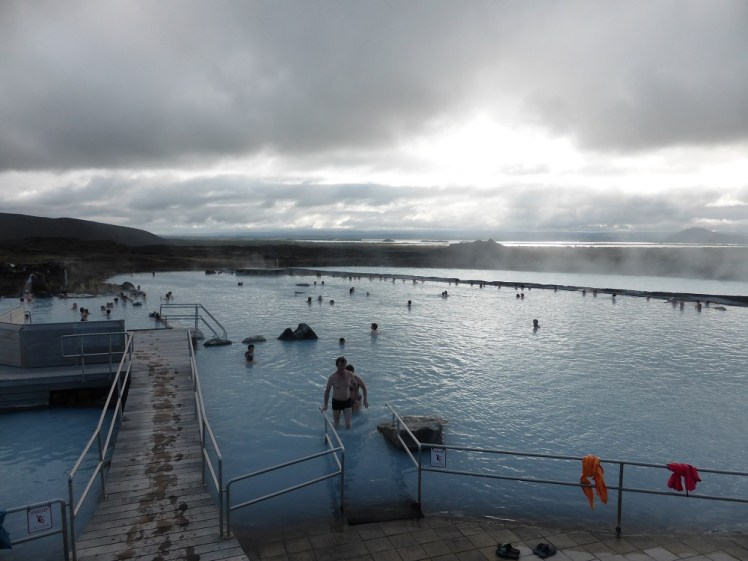
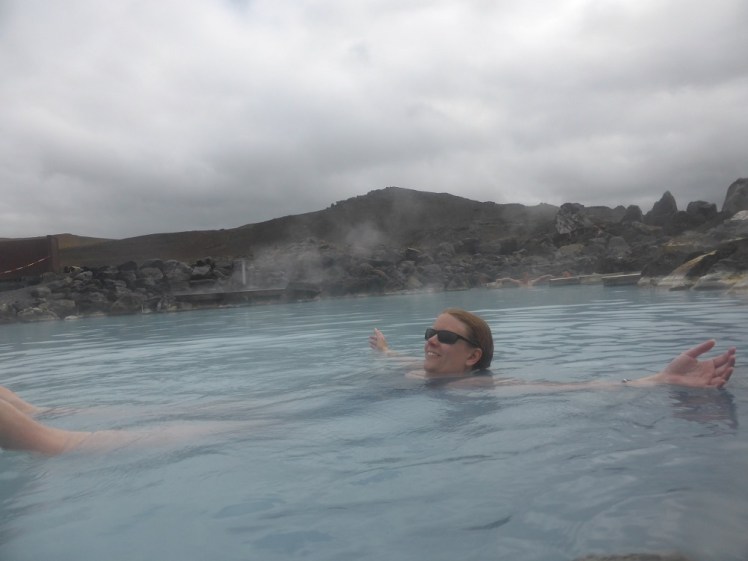
Stay in Myvatn tonight – there are two good campsites, a decent hotel and probably a few guesthouses because otherwise you’ll have a really long day tomorrow.
Day four
We’re having another long and very special day today! Book yourself an Askja tour! Like Landmannalaugar, you can do this on a large bus or on a small jeep but even the large bus will be on the smaller side and when it arrives, it’ll probably be the only one.
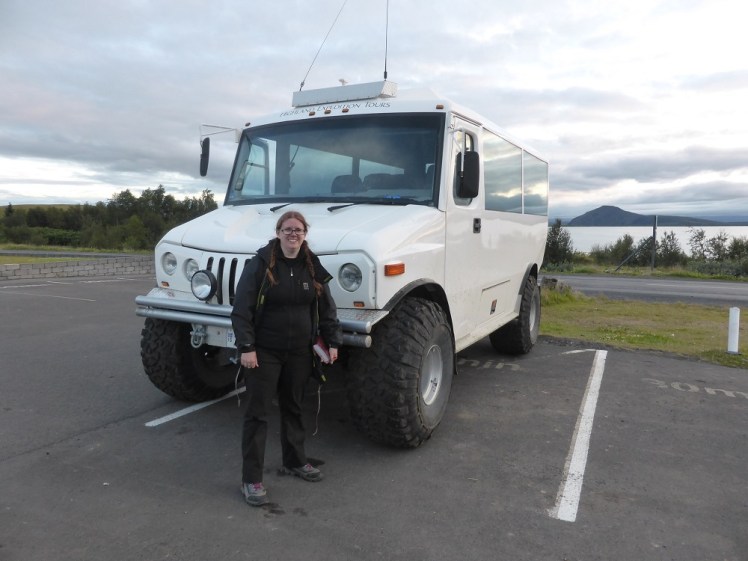
You head east on the Ring Road and then turn abruptly onto the Ódáðahraun, which means the Desert of Misdeeds, a huge barren lava field that makes all other lava fields look friendly and welcoming. You 100% cannot drive yourself here. The road is too rough, there are too many crossings and the road is barely even a track. I’d personally do the Holuhraun and Askja trip which starts the day with a visit to the lava field created in the 2014-15 eruption. It’s about the size of Manhattan and is in the top three biggest lava fields created in human history. You may not have heard about it at the time because it happened in the middle of nowhere during the winter and was only really accessible to volcanologists and the occasionally really determined journalist with the right press pass, or ability to get supplies like gas masks. It did zero harm to humans or habitations and thus didn’t make great international news. I thought it was very exciting and you can extend your Askja trip with a visit out here if you find the right company.

But the big draw is your trip to Askja, a volcano formed of several calderas nesting within each other. The inner one is flooded with a dark blue lake a few hundred metres deep. Don’t swim in it. Two scientists went missing on it in a wooden rowing boat and were never seen again and the cliffs around the size occasionally collapse and cause localised tsunamis. Besides, it’s a volcano several hundred metres deep, doesn’t that just scream monsters to you?

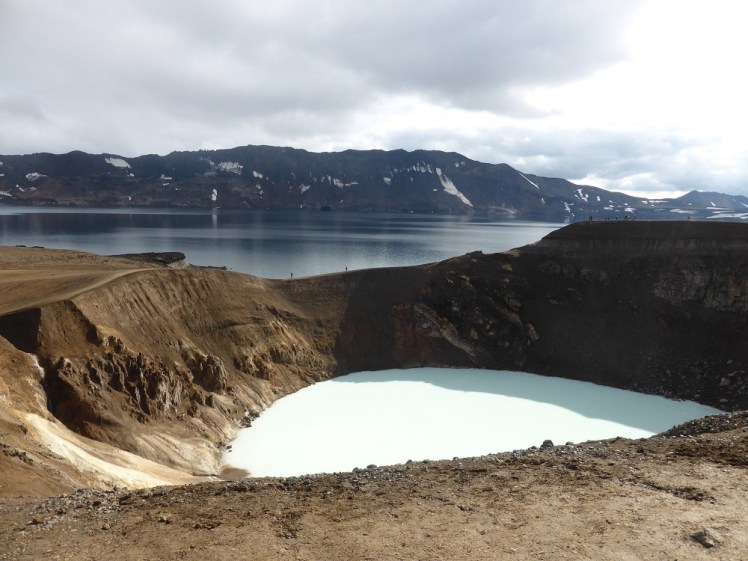
No, your swim today is in hell. That is, in Icelandic, Viti, the small crater on the side. It’s flooded to a depth of a mere 75m with opaque baby blue water which is warm. In fact, to be honest, it’s just a little on the lukewarm side, but I’ll take anything above freezing for the opportunity to swim in a flooded volcano. (Read my blog about it here) It’s a hike of about 35m from the car park across the caldera to Viti and then it’s a pig of a scramble down its muddy side to the bit of “beach” which functions as a changing room. Even more of a pig back up afterwards. Get comfortable changing in front of other people and take a drybag to keep your stuff clean and dry for afterwards. Then wade into the warm blue water, which has naturally flooded a volcano. This is once-in-a-lifetime. See how I couldn’t leave this out, despite the awkwardness of the trip down? You may even get to discover really and truly for yourself that pumice does float. I have a tiny piece somewhere that floated past me on my swim – for Askja tends to erupt yellow pumice. That’s why this area is so barren. The pumice poisons the land and because it’s so light, it can spread a long way. Listen to the car or coach tyres as you go back. Listen to the crunching crackling noise. Pumice.

It’ll be quite late by the time you get back to Myvatn so you won’t get anything else done today but hey, you swam in hell in a volcano!
Day five
Time to fly back to Reykjavik. Depending on what time your flights are, you may have time for another trip to the Nature Baths or you may have time to go back into Reykjavik but what’s on my itinerary today is the thing I tried not to include because it’s been done so many times. But how could I wrote an itinerary for Iceland for waterbabies without including a trip to the Blue Lagoon. Yeah, go to the Sky Lagoon instead if you don’t want to be so obvious but one of the charms of the Blue Lagoon is that there is the infrastructure to drop you there on your way to the airport and it is worth a visit, especially if you’re a fan of geothermal hot water.
On the other hand, the Sky Lagoon has its seven-step Ritual, which involves hot and cold water and vapour. I daresay you could recreate most of it at the Blue Lagoon if you wanted to really appreciate the application of warm water but this is a thing you pay for at the Sky Lagoon and so it’ll guide you through each step. Great views from the Sky Lagoon too. It’s on the end of the headland south of Reykjavik so you’ll look straight out to sea and it faces west so it gets great sunsets.
But for today we’re going to go to the Blue Lagoon. Just before you arrive, you’ll pass the Svartsengi power station. The water in the Blue Lagoon is waste water from the power station – it’s brought up from hundreds of metres below the ground at a pressure that allows it to remain liquid well beyond the point when it would vaporise at the surface, which is what happens as it comes up. It turns to steam, the steam turns the turbines, the turbines generate electricity and the steam is funnelled back into a condenser where it turns back to water. It then goes to cooling pools before being returned to the Earth to be reheated but some of it is diverted to the Blue Lagoon, once it reaches a safe temperature for swimming.

That view’s not as intrusive as I’m making it look and I do think it’s worth keeping in mind what’s behind this wonderful spa. Endless hot water coming from this renewable energy and don’t forget, you’re luxuriating in power station runoff.
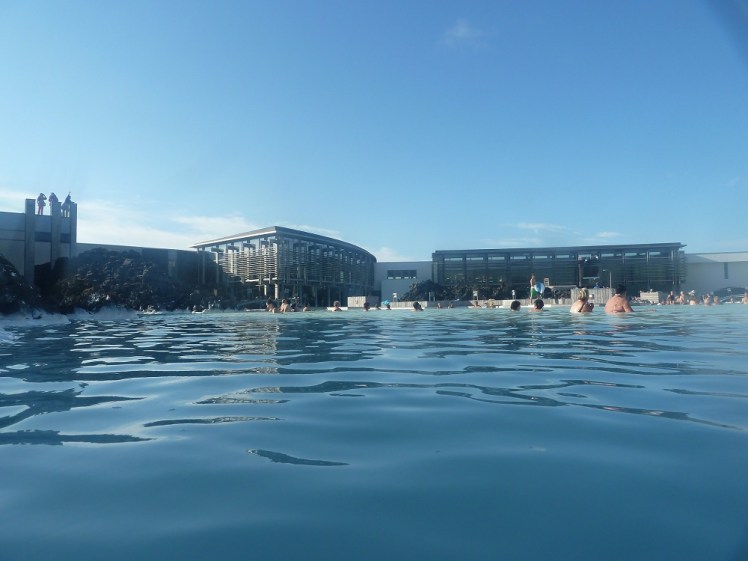
Honestly, it’s magical. It’s opaque blue-white, it’s surrounded by low black and white lava mountains, you can see the power station humming away next door from certain angles, it’s got a swim-up bar and a swim-up face mask station, there’s a cafe inside and a restaurant out in the lobby and even though I’ve been there more times than I could count, I’d still do it again. These days you need to book in advance, not just turn up – that’s been their policy since at least 2016 or 2017, whichever one it was when I got turned away for not booking. It’s not a plague thing, it’s a simple capacity, overtourism problem. Numbers are restricted but it gets quieter very rapidly towards the end of the day.
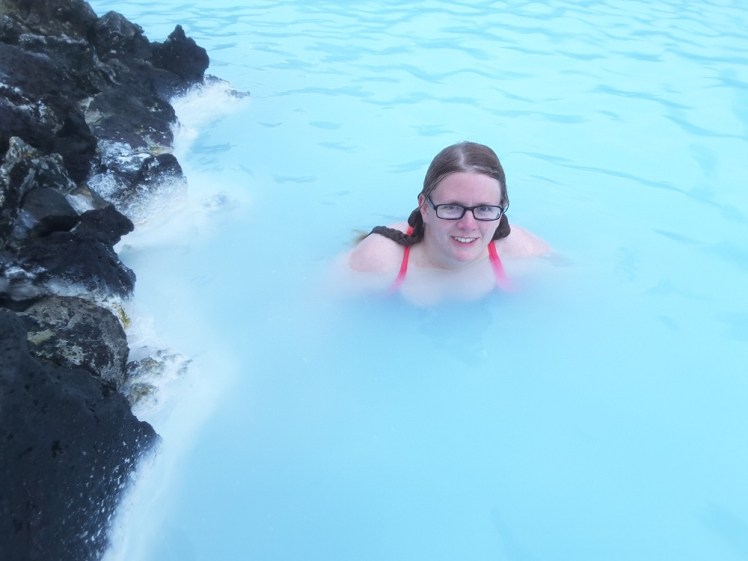
And then you get out of the pool, you get dried and dressed and you return to the bus to be taken to the airport after five days having many different geothermal experiences, with really soft skin and probably really dry hair. Condition it well when you get home.